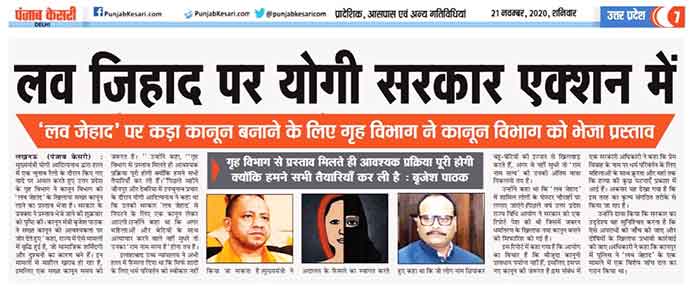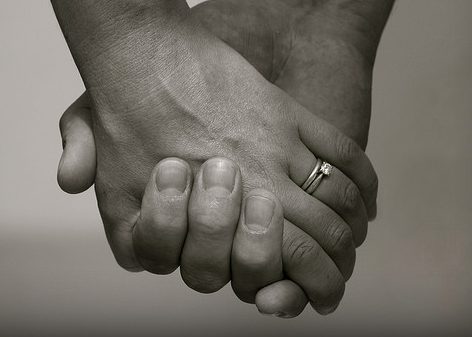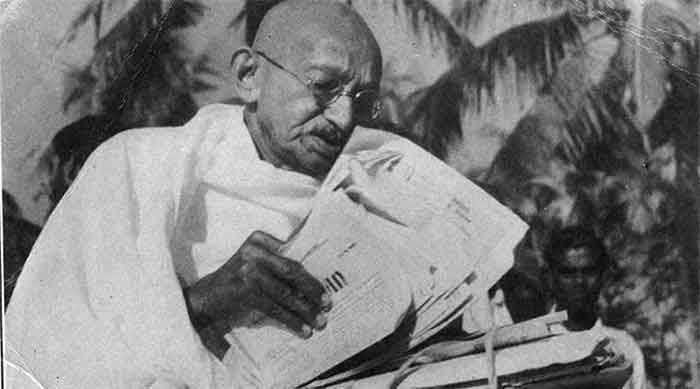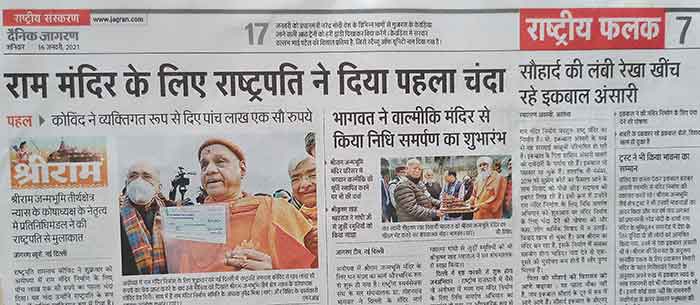
Several leading Hindi newspapers have brazenly mouthed the Hindutva narrative of anti-woman and anti-Muslim “Love-Jihad” conspiracy theory and justified the proposal of the BJP ruled state to come out with a strong law against it.
“Love-Jihad” is a conspiracy theory designed and propagated by the Hindutva forces to demonize the Muslim men for feigning love for the Hindu women. According to the Hindutva narrative, Muslim men marry Hindu women and later convert them into Islam for changing the religious demography of the country.
Several scholars have pointed out that the term “Jihad” has no connection whatsoever with the alleged forceful conversion. An Arabic term “Jihad” is made of the verb “ja-ha-da”(جَهَدَ) which means “to do effort” or “to strive”. It has no connotation with either conversion or the so-called fraud done on Hindu women.
Among the BJP-ruled states, the Yogi Adityanath-led Uttar Pradesh Government may become the first state to bring out an ordinance to stop “forceful” and “unlawful” conversion. Last year, the Uttar Pradesh Law Commission submitted a report, stating that “conversion done for sole purpose of marriage to be declared null and void”.
The Commission also prepared a draft for “Uttar Pradesh Freedom of Religion Act, 2019”. According to the government sources, conversion done for the single purpose of marriage will become null and void. Moreover, the person involved in the act of forceful conversion may be jailed for up to six months with a fine of Rs. 10,000.
A clear indication towards such a law was recently given by the Chief Minister Yogi Adityanath himself. Speaking at a public meeting held in Jaunpur on October 30, he said that those who are forcefully doing conversion will be punished. The media reports suggest that other BJP-ruled states are also considering bringing a law against “Love-Jihad”.
The opposition leaders, however, have criticized the BJP for trying to divide the nation by bringing a law against the so-called “love-jihad”. For example, the Rajasthan Chief Minister Ashok Gehlot has registered a strong objection to the proposed law: “Marriage is a matter of personal liberty (and) bringing a law to curb it is completely unconstitutional and it will not stand in any court of law”.
It is shameful that the several Hindi newspapers have come out in support of “Love-Jihad”. For example, Dainik Jagran, one of the largest circulating Hindi newspapers, pens an editorial (November 21, 2020) titled “Inter-religious marriage” (antar dharmik vivah) and propagates Hindutva narrative that in the cases of the inter-religious marriages, the bridegrooms are often Muslims. “This is a fact that in all cases related to the inter-religious marriages a girl (yuvati) has to embrace the religion of the boy (yuvak). It has been seen in many cases that the marriage does not take place without the conversion. Since it is often seen that such marriages take place between the Hindu/Christian bride and the Muslim bridegroom, the organizations from both the communities take an objection to it”.
Next day, the Dainik Jagran (National, November 22) publishes an opinion piece by Anant Vijay who similarly justifies a law against “Love-Jihad”. “Given that the cases of love jihad have increased of late, it is proper that enacting a law against it is being considered. Social evil like love jihad cannot be eradicated only through law. There is also a need to work in the field of culture and education”. His emphasis on working in cultural and educational domains is a euphemism for further penetration of Hindutva agendas in the civil society.
Rashtriya Sahara, another leading daily, toes the Hindutva agenda. The story about the proposed ordinance against “Love-Jihad” has been prominently covered. A three-column story on the first page reads, “Yogi Government ready for bringing a tough law against love jihad” (Love jihad par sakht qanoon ki aor Yogi Sarkar). The opening lines claim that “the cases of love jihad have increased in the state” but it does not give any substantive evidence in its support.
Similarly, the Punjab Kesari (New Delhi, November 21) carries an eight-column story (p. 7) titled “Yogi Government swings into action against Love-jihad” (Love jihad par Yogi Sarkar action men). It also carries a picture of a woman whose half face is clad with a sari and the other half is covered with burqa. The image gives an impression that how a Hindu girl (bearing sari) is being forced to become a Muslim (putting on burqa) through the process of love-jihad.
The same day Aditya Narayan Chopra writes an editorial for Punjab Kesari. He, too, justifies the move and peddles the communal narrative: “The boys from the Muslim society change their name and resort to fraud means. They egg Hindu girls on to go for marriage and get their (Hindu girls) religion changed”.
Unfortunately, the Hindi media has again failed its duty to uphold gender and minority rights. Again it has chosen not to speak against bigotry and hatred. Nor is it willing to analyze the issue of “Love-Jihad” and its kind in a historical and sociological perspective.
The media is reluctant to tell us that the Hindutva forces, since the days of communal polarization in the 19th century, have been constructing the image of Muslim men as “violent”, who often indulge in attacking Hindu women. Not only that the issue of conversion has also been historically used to scare Hindu community. Several myths and lies have been propagated about how Hindus have been “forcefully” and “deceitfully” converted by the Muslims. If the media had been critical, it would have hit the nail on the head.

Why does the Hindi press, however, go along with the Hindutva currents? Perhaps, two reasons account for it. First, the Hindi press does not want to annoy its patrons sitting in the corridors of power and those controlling the helm of economic activities. In most of the cases, those who are at the helm of economic activities are also funding and running the newspapers. Secondly, it does not want to take the risk of appearing “unpopular” in the communal cultural sphere within which a Hindi newspaper has to operate. The communal cultural sphere, needless to say, has been built up over a long period of time by the Hindutva forces and one needs a lot of courage to challenge the communal narrative.
(Abhay Kumar is a Ph.D. from JNU. He is broadly interested in Minority and Social Justice. Earlier, he held a Post-Graduate Diploma in English Journalism from the Indian Institute of Mass Communication, New Delhi, and worked as a Delhi-based reporter with The Indian Express. You may write to him at [email protected]).
SIGN UP FOR COUNTERCURRENTS DAILY NEWSLETTER















































